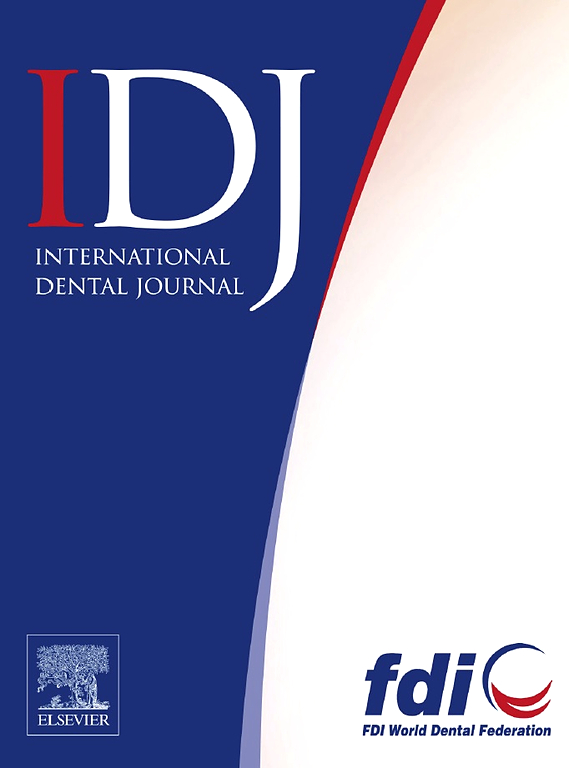A Nanoparticle, Fluorescence-Based Rinse for Caries Activity Assessment, an in Vitro Study
IF 3.2
3区 医学
Q1 DENTISTRY, ORAL SURGERY & MEDICINE
引用次数: 0
Abstract
Objectives
This in vitro study aimed to compare the agreement of a starch-based nanoparticle fluorescence rinse (FR) (LumiCare™ Caries Detection Rinse, GreenMark Biomedical Inc.) in the assessment of caries activity of initial smooth surface carious lesions with the International Caries Classification and Management System (ICCMS) Lesion Activity Assessment.
Methods
A convenience sample of permanent extracted human teeth (N = 57) were scored by visual assessment (VA) using the ICCMS activity criteria by 2 calibrated examiners. VA categories included: sound, inactive and active. For fluorescence assessment (FA), each tooth was fully immersed in FR for 30 seconds, rinsed with water for 10 seconds, compressed air dried and examined under an orange filter while illuminating with a curing light. Fluorescence was assessed as no fluorescence or fluorescence. Both VA and FA were repeated after at least 24 hours and Kappa was calculated for inter- and intra-examiner agreement.
Results
Based on VA, 12 teeth (21%) were classified into the active category, while 45 teeth (79%) were classified into the sound (n = 20) or inactive (n = 25) categories. When combining the latter 2 categories, VA and FA’s classifications were concordant in 100% of cases (all 12 teeth in VA’s active category exhibited fluorescence, and all 45 teeth in VA’s sound/inactive category did not exhibit fluorescence according to FA; Kappa = 1).
Conclusion
FA with FR demonstrated perfect agreement with VA using ICCMS when comparing active versus inactive and/or sound surfaces suggesting it has potential as an objective indicator of caries activity.
Clinical significance
A fluorescence rinse could improve clinical detection of smooth surface caries activity and could easily be integrated as part of the dental hygiene appointment.
一种用于龋活性评估的纳米颗粒荧光冲洗液,一项体外研究
目的:本体外研究旨在比较淀粉基纳米粒子荧光冲洗(FR) (LumiCare™龋齿检测冲洗,GreenMark Biomedical Inc.)在评估初始光滑表面龋齿病变的龋齿活性方面与国际龋齿分类和管理系统(ICCMS)病变活性评估的一致性。方法采用ICCMS活度标准,由2名校正后的审查员进行视觉评分(VA)。VA分类包括:声音、不活动和活动。为了进行荧光评估(FA),将每颗牙齿完全浸入FR中30秒,用水冲洗10秒,压缩空气干燥,在橙色滤光片下检查,同时用固化光照射。荧光分为无荧光和荧光。至少24小时后重复VA和FA,并计算Kappa以确定审查员之间和内部的一致性。结果按VA分为活动牙12颗(21%),正常牙45颗(79%),不活动牙25颗(n = 20)。合并后两类时,VA与FA的分类在100%的病例中是一致的(根据FA, VA活跃类的12颗牙齿全部显示荧光,VA健全/不活跃类的45颗牙齿全部不显示荧光;Kappa = 1)。结论用ICCMS比较活性表面与非活性表面和/或声音表面时,fa和FR与VA完全一致,表明它有潜力作为龋活性的客观指标。临床意义荧光冲洗可提高临床对光滑表面龋活性的检测,并可作为口腔卫生预约的一部分。
本文章由计算机程序翻译,如有差异,请以英文原文为准。
求助全文
约1分钟内获得全文
求助全文
来源期刊

International dental journal
医学-牙科与口腔外科
CiteScore
4.80
自引率
6.10%
发文量
159
审稿时长
63 days
期刊介绍:
The International Dental Journal features peer-reviewed, scientific articles relevant to international oral health issues, as well as practical, informative articles aimed at clinicians.
 求助内容:
求助内容: 应助结果提醒方式:
应助结果提醒方式:


